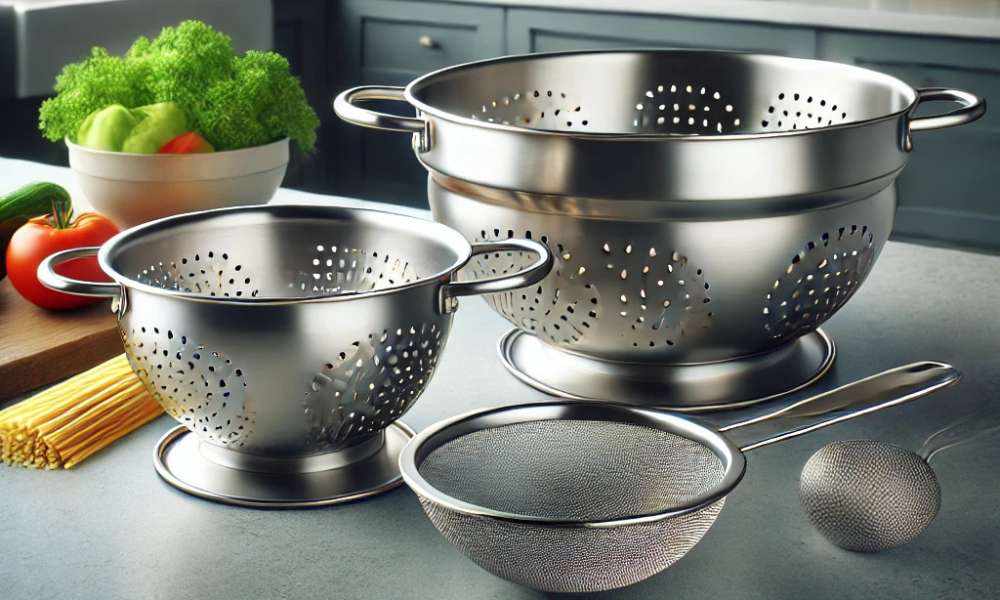In the realm of culinary tools, few items are as deceptively simple yet profoundly essential as the colander and the strainer. While they might seem interchangeable at first glance, their unique designs and functionalities serve distinct purposes. Recognizing the difference between these tools can enhance your efficiency in the kitchen and elevate your cooking experience. Whether you’re draining pasta, rinsing vegetables, or sifting flour, the right tool can make all the difference.
What Is A Colander?
A colander is a perforated bowl, typically crafted from materials like stainless steel, plastic, or silicone. Its primary function is to drain water or other liquids from solid foods, such as pasta, boiled vegetables, or washed produce. Colanders are known for their wide, bowl-like shape, which allows them to hold large quantities of food at once.
The holes in a colander are larger compared to a strainer, making it less suitable for finer tasks like filtering out small particles. However, the sturdy construction and spacious design make it a go-to tool for heavy-duty draining. Many colanders come with handles and a stable base, such as a pedestal or legs, to facilitate hands-free use.
Advantages of Colanders:
- Ideal for draining larger foods like pasta or potatoes.
- Stable and easy to use with larger volumes of food.
- Often dishwasher-safe, ensuring hassle-free cleanup.
What Is A Strainer?
A strainer, on the other hand, is a more versatile kitchen tool. It features a fine mesh or perforated design and is typically used for tasks that require precision. Strainers come in various shapes and sizes, from small handheld versions to larger models with a handle and resting hooks.
Strainers excel in filtering out smaller particles, making them indispensable for tasks like sifting flour, straining sauces, or even steeping tea. Their finer mesh makes them less suitable for heavy-duty tasks but perfect for more delicate operations.
Types of Strainers:
- Fine Mesh Strainers: Perfect for sifting flour, separating pulp, or removing impurities from liquids.
- Conical Strainers (Chinois): Often used in professional kitchens for sauces and soups.
- Skimmers: Designed for removing food from hot liquids, such as frying oil or boiling water.
Key Differences Between A Colander And A Strainer
Despite their overlapping uses, the colander and the strainer differ in key aspects:
| Feature | Colander | Strainer |
| Design | Bowl-shaped with larger holes | Fine mesh or small perforations |
| Purpose | Draining water from larger food items | Filtering small particles and impurities |
| Size | Typically larger | Available in various sizes |
| Common Uses | Pasta, vegetables | Sauces, flour, tea |
Material Choices: Colander vs. Strainer
The material of your kitchen tool significantly influences its durability, performance, and maintenance. Colanders are often made of stainless steel, which resists rust and offers longevity, or plastic, which is lightweight and inexpensive. Silicone colanders provide flexibility and heat resistance.
Strainers, given their finer mesh, are usually crafted from stainless steel or durable nylon. Each material has its pros and cons, and selecting the right one depends on the intended use. Stainless steel strainers, for example, are excellent for hot liquids due to their heat resistance, while nylon strainers are gentle on nonstick cookware.
Design Variations And Their Impact
The design of colanders and strainers plays a pivotal role in their usability. Colanders with a stable base and large handles provide ease of use for draining heavier items. Meanwhile, strainers with long handles and resting hooks allow for hands-free operation when filtering liquids.
The depth and fineness of the perforations also matter. A colander’s larger holes enable rapid draining but might not catch smaller food particles. Strainers, with their finer mesh, ensure precision but require more effort to clean.
Best Uses For A Colander
Colanders shine in tasks requiring the handling of bulkier foods. Washing fruits and vegetables, draining boiled potatoes, or even storing washed greens become seamless with a well-designed colander. Its large size and sturdy structure make it ideal for these applications.
Best Uses For A Strainer
Strainers are indispensable for finer tasks. From sifting powdered sugar over baked goods to straining out herbs from a broth, their precision is unmatched. They are particularly handy for bakers and mixologists, ensuring no unwanted lumps or particles ruin a dish or drink.
Colander vs. Strainer For Cooking Pasta
When it comes to draining pasta, both tools can be used, but colanders have the upper hand. Their large size and sturdy design accommodate heavy pasta dishes without risk of spillage. Strainers, however, are better suited for smaller portions or for rinsing cooked pasta to remove excess starch.
Colander vs. Strainer For Washing Produce
Colanders are the preferred choice for rinsing produce, thanks to their wide openings and capacity. Strainers, while usable, are better for smaller items like berries, where precision rinsing is key.
Fine Mesh Strainers vs. Regular Strainers
The choice between fine mesh and regular strainers hinges on the level of precision needed. Fine mesh strainers are indispensable for tasks like sifting or clarifying sauces, whereas regular strainers work well for draining liquids where some residue is acceptable.
Durability And Maintenance
Proper care ensures longevity for both tools. Stainless steel versions are dishwasher-safe and highly durable, while plastic and nylon require gentle cleaning to prevent warping or tearing. Regular inspection and immediate cleaning after use help maintain functionality.
Conclusion
Understanding the nuanced differences between a colander and a strainer empowers home cooks to select the right tool for each task. These humble kitchen essentials may appear simple, but their specialized designs cater to distinct culinary needs, making them indispensable for any well-equipped kitchen. By choosing wisely, you ensure efficiency, precision, and a smoother cooking experience.
